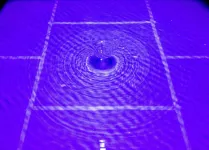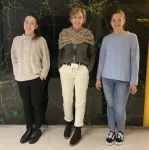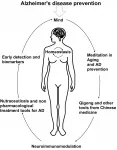New realm of personalized medicine with brain stimulation
Researchers' "skeleton key" can unlock a brain
2021-02-01
(Press-News.org) Millions of patients suffering from neurological and mental disorders such as depression, addiction, and chronic pain are treatment-resistant. In fact, about 30% of all major depression patients do not respond at all to any medication or psychotherapy. Simply put, many traditional forms of treatment for these disorders may have reached their limit. Where do we go from here?
Research to be published in Nature Biomedical Engineering led by Maryam Shanechi, the Andrew and Erna Viterbi Early Career Chair in electrical and computer engineering at the USC Viterbi School of Engineering, paves the way for a promising alternative: personalized deep brain stimulation. The work represents a major step forward in achieving new therapies for a whole host of neurological and mental disorders.
Until now, the challenge of personalized deep brain stimulation has been the human brain itself. Mental disorders can manifest differently in each patient's brain. Similarly, whether and how each patient's brain activity and their symptoms will respond to stimulation can be very different. This makes it difficult to know the effect of stimulation in a given patient or how to change the dose of stimulation - that is, its amplitude or frequency - over time to tailor it to a patient's needs.
Shanechi and her team have found a way to predict what effect electrical stimulation will have on an individual's brain activity across multiple brain regions by developing new stimulation waveforms and creating new machine-learning models. They demonstrated the success of the model in actual brain stimulation experiments in collaboration with Bijan Pesaran, Professor of Neural Sciences at NYU.
To accomplish this, they designed two tools: a novel electrical stimulation wave to map brain activity; and new machine-learning techniques that learn the map from brain data collected during stimulation. "Our wave, which changes its amplitude and frequency randomly in time, allowed us to see and predict how the brain responded to a wide range of stimulation doses," said Shanechi. Much like a skeleton key can unlock any door, the wave can be applied to any individual's brain and provide a personalized map of how it responds to stimulation. To test their hypothesis, the researchers applied their wave on four different regions of the brain. In each case, they were able to predict the outcome on brain activity across multiple regions for the first time.
What this means is that doctors may soon be able to personalize a "dose" of deep brain stimulation on a case-by-case basis and in real-time by changing the amplitude and frequency of stimulation. Think of it as the brain stimulation version of increasing or decreasing the number of milligrams in a pill. For people suffering from mental disorders like treatment-resistant depression or anxiety the implications are massive.
Shanechi and her team had previously developed machine learning techniques to decode symptoms of mental disorders such as mood from brain activity. Now, with their new ability to better predict how stimulation affects brain activity on an individual basis, they seek to combine their findings toward personalized therapies for mental disorders. "By putting these two boxes together, we hope to build closed loop brain-machine interfaces that adjust the dose of electrical stimulation therapy by tracking the symptoms in real-time based on brain activity and by predicting how a change in stimulation can change the activity and thus these symptoms," said Shanechi.
INFORMATION:
Authors: The study's authors were Yuxiao Yang, Shaoyu Qiao, Omid G. Sani, J. Isaac Sedillo, Breonna Ferrentino, Bijan Pesaran, and Maryam M. Shanechi
ELSE PRESS RELEASES FROM THIS DATE:
2021-02-01
King Richard III's involvement in one of the most notorious and emotive mysteries in English history may be a step closer to being confirmed following a new study by Professor Tim Thornton of the University of Huddersfield.
Richard has long been held responsible of the murder of his nephews King Edward V and his brother, Richard, duke of York - dubbed 'the Princes in the Tower' - in a dispute about succession to the throne. The pair were held in the Tower of London, but disappeared from public view in 1483 with Richard taking the blame following his death two years later.
It has become of the most enduring unsolved mysteries of all, stoked by references in Shakespeare's play about the ...
2021-02-01
Skoltech researchers helped their colleagues from Japan, Germany, the United States, and China study the crystal structure and optical properties of a new class of two-dimensional compounds, which can be used as effective visible-light-responsive photocatalysts for energy and chemical conversion. They used the Advanced Imaging Core Facility equipment for imaging and structural analysis. The paper was published in the Journal of the American Chemical Society.
One potential use of photocatalysts, so-called water splitting can help substitute climate-warming fossil fuels with more environmentally friendly hydrogen. For this process to work on ...
2021-02-01
It has sometimes been suggested that humans use a tiny fraction of their brains. But, is this statement true? The authors of a study published on 20 January in the journal Nature Communications answer this question using neural records of mice subjected to visual stimuli.
This paper demonstrates, in the visual system of mice, the presence of a type of coordination of neural activity called differential correlations. A study by Rubén Moreno-Bote, a researcher at the Center for Brain and Cognition (CBC) and Serra Hunter research professor with the UPF Department of Information and Communication Technologies ...
2021-02-01
Scientists have revealed new insights into the behaviour of black holes with research that demonstrates how a phenomenon called backreaction can be simulated.
The team from the University of Nottingham have used their simulation of a black hole, involving a specially designed water tank, for this latest research published in Physical Review Letters. This study is the first to demonstrate that the evolution of black holes resulting from the fields surrounding them can be simulated in a laboratory experiment.
The researchers used a water tank simulator consisting of a draining vortex, like the one that forms when you pull the plug in the bath. This mimics a black hole since a wave which comes too ...
2021-02-01
Protein alteration in the family of lamins causes several diseases, known as laminopathies, such as progeria or precocious ageing. A study in which UB researchers have taken part states that alterations in the levels of one of these proteins, lamin B1, contribute to the degeneration of different brain neuronal populations in Huntington's disease. Caused by a mutation in the huntingtin gen, this pathology features involuntary movements, cognitive deficit and psychiatric disorders, and has no cure yet.
According to the study, published in the journal EMBO Molecular Medicine, these results open new therapeutic pathways for the treatment of this disease, since research shows pharmacological normalization of levels of lamin ...
2021-02-01
As COVID-19 spread across the world, so did conspiracy theories and false information about the virus. This proliferation of misinformation--labeled an "infodemic" by the World Health Organization (WHO)--makes it difficult to identify trustworthy sources and can threaten public health by undermining confidence in science, governments, and public health recommendations.
The consequences of misinformation can be tragic: hundreds died and thousands were poisoned in Iran after consuming toxic methanol alcohol, falsely believing it could cure COVID-19.
In a new article in the Journal of Public ...
2021-02-01
The COVID-19 pandemic is straining health systems across the country, especially intensive care units. New research from the U.S. Department of Veterans Affairs, Regenstrief Institute and Indiana University School of Medicine shows that people treated in the ICU for COVID-19 are twice as likely to die when the ICU capacity is strained by the number of COVID-19 patients.
"These results demonstrate that patients with COVID-19 are more likely to die if they are admitted to an ICU during times with peak COVID-19 caseload," said Dawn Bravata, M.D., first author of the study. "We know that strain on hospital ...
2021-02-01
Amsterdam, December 29, 2020 - This new pioneering study by Prof. Ricardo Maccioni and coworkers of the International Center for Biomedicine, "New Frontiers in the prevention, diagnosis and treatment of Alzheimer´s disease" was published in the special issue of Latin American investigators of the Journal of Alzheimer's Disease(JAD). This supports a growing body of research on the Alzheimer's prevention value of an integrated approach using daily exercise, nutraceuticals, oriental practices such as QiGong along with meditation, and social life. These elements of a healthy style of life are supplemented with the use of reliable biomarkers for early detection of this disease that allows the detection of Alzheimer up to 20 years before ...
2021-02-01
Chronic stress could be the prevailing condition of our time. In the short term, our jaws or stomachs may clench; in the long term, stress can lead to metabolic disease and speed up diseases of aging, as well as leading to more serious psychological disorders. The physical manifestations of stress originate in the brain, and they move along a so-called "stress axis" that ends in the adrenal glands. These glands then produce the hormone cortisol. When the stress axis is continually activated, changes occur in the cells and organs along the way, and the continual production of cortisol then substantially contribute the symptoms of chronic stress.
The stress response axis starts with the hypothalamus in the brain, ...
2021-02-01
Scientists say stable seafood consumption amongst the world's poorer coastal communities is linked to how local habitat characteristics influence fishing at different times of the year.
In the coastal communities of low-income countries, the seafood people catch themselves is often a main food source. In a new study, scientists focused on an often-overlooked type of fishing called gleaning: collecting molluscs, crabs, octopus and reef fish by hand close to shore.
"We surveyed 131 households in eight coastal communities on a small island off Timor-Leste," said study lead author Ruby Grantham from the ARC Centre of Excellence for Coral Reef Studies.
Grantham said even though gleaning is important for food security ...
LAST 30 PRESS RELEASES:
[Press-News.org] New realm of personalized medicine with brain stimulation
Researchers' "skeleton key" can unlock a brain




